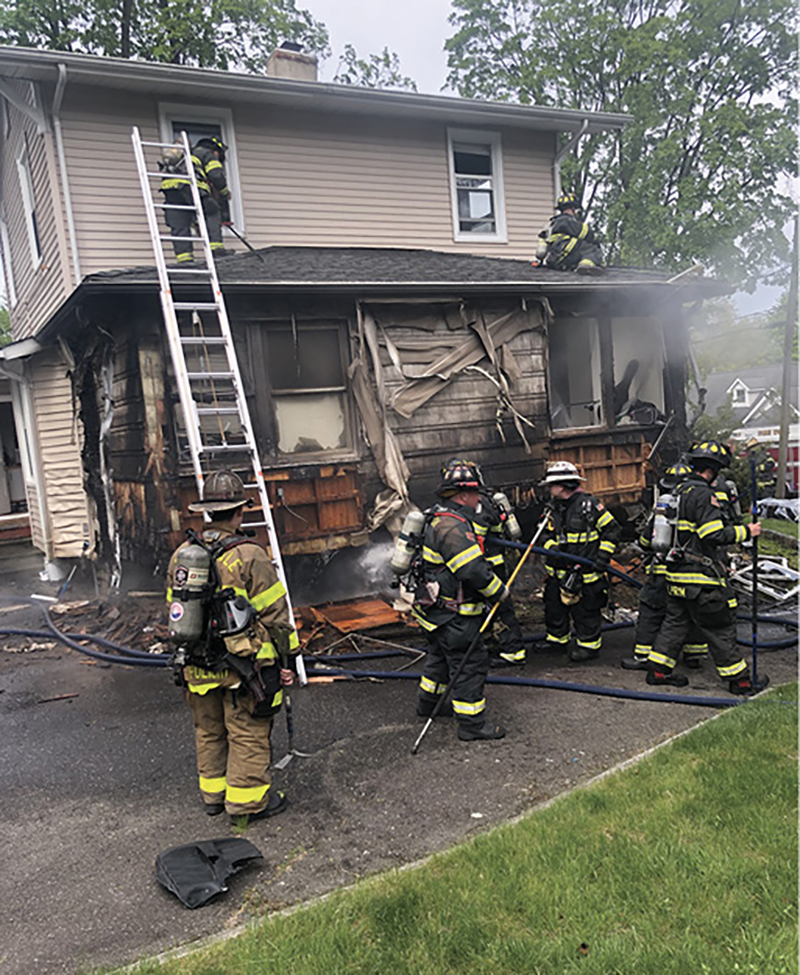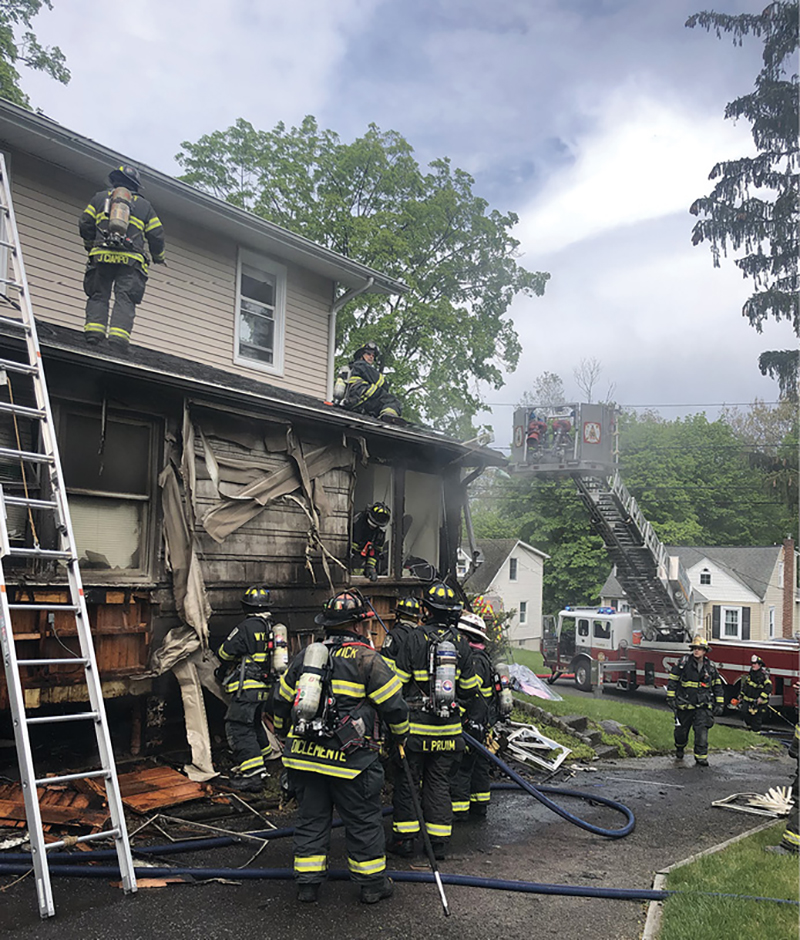FIRE FOCUS | by MICHAEL N. CIAMPO
All across the country in various types of private dwellings, porches, whether on the front, side, or rear of homes, have been renovated. Open-air porches that were once just screened in are now fully enclosed to give more square footage to the occupants who live in the dwelling. In older renovations, many of these porches were enclosed without any insulation in the walls or beneath them. There may be a crawl space under them that is either fully enclosed or wide open. The heights under these porches can be minimal, or there may be several feet below them, which can be enclosed and used for storage or be wide open. Electrical lines, gas lines, and water lines for baseboard heat or for appliances can also be found running under these porches.
- Porches: Not As Inviting As You May Think
- Construction Concerns: Porches, Decks, and Stairs
- FIGHTING REAR PORCH FIRES
On a hot and humid weekend day, the Wyckoff (NJ) Fire Department responded to a report of a structure fire. On arrival, members could see flames coming from under the enclosed porch and engulfing the whole side, front, and rear of the enclosure.
The initial-arriving chief quickly performed a 360° size-up and was informed by the homeowner that all residents were out of the building. Looking inside the home, the chief could see the fire hadn’t entered the porch area yet, although the windows were all being exposed to heavy flames and the smoke condition was getting worse. Since the town’s tower ladder was out of service for repairs, the chief made an immediate request for an adjoining town’s truck company to respond to the scene.

(1) The initial attack line had to extinguish fire on three sides of the porch. (Photos by Megan Ciampo.)

(2) You may not be able to place a portable ladder to the porch roof until the bulk of the fire has been knocked down.

(3) The engine and rescue company pulled past the building, leaving access for truck positioning.
The first-arriving engine company stretched a 200-foot, 1¾-inch preconnected hoseline off the rear of the rig. The chauffeur ensured he pulled the apparatus past the structure to leave room for the incoming truck company. The bulk of the fire was quickly knocked down with the initial attack line, but other areas of concern still existed. The windows had cracked and failed, and the fire had extended into the walls and around the window frames.
Crews were sent inside the structure to open up the areas to ensure fire wasn’t traveling in unseen areas. Meanwhile, a second hoseline was stretched to cover the inside of the home to extinguish any possible extension and protect the members operating.
In addition, because the smoke was pushing from the porch roof level, nearest to where it was attached to the home, a crew was sent to that location to check for extension. A 24-foot portable ladder was placed in position for porch roof access. Because it would be faster for an interior team to pull the baseboard moldings on the second floor of the home and crews to pull the ceiling inside the porch to check for extension, the roof was not cut. Not only was this faster to perform, it also reduced the damage to the structure and reduced the repair costs for the homeowner.

(4) Covering two sides of the private dwelling will assist tower ladders in covering more scrub area.

(5) The tower ladder bucket provides a valuable work platform for opening up and visually checking hard-to-reach areas for fire extension.

(6) Always secure the electrical utilities when overhauling with hand and power tools.
With limited extension inside the porch, crews opened up the baseboards as well as the walls where the fire had extended. The majority of the overhaul work had to be done on the outside of the structure. The burnt layers of siding on the structure (vinyl over wood shakes) had to be removed and the structure’s studs washed down to prevent any rekindle. In some areas, power saws were used to remove deep charred pieces of the siding and expose orange embers that kept dropping down when the hoseline was used to wash down the structure.
The hoseline was deployed by a firefighter operating on one knee and directing a stream upward, to wash down the burnt floor joists beneath the deck. The incident commander (IC) was fearful that the water wouldn’t penetrate the areas well enough to prevent a rekindle because of the depth of char beneath the porch. A low-velocity applicator (a bent pipe with a tip on the end, often referred to as a Navy nozzle because of its use at shipboard fires) was called for and attached to one of the nozzles. It was then slid under the deck to wash down the joists and underside of the floor deck that were damaged by the fire.
Prior to taking up the hoseline, crews checked the area again visually and with the thermal imaging camera for any signs of heat or smoke emitting from the area. The IC also had units check the attic for smoke and fire extension. Since this was a balloon-frame structure, the fire could have run upward and gone unnoticed; luckily, no extension occurred.
Sizing Up Porch Characteristics
- Older porches may sit on brick piers that may be structurally unstable from age. They may also be affected by the heat of the fire and in danger of collapse when weight is shifted around inside the building. The piers or columns are often enclosed and aren’t visible or regularly inspected. In addition, they may have not been originally built for all the weight (room furnishings, appliances, live loads) that they now support.
- With older homes, firefighters may encounter balloon framing with asphalt shingles under newer vinyl siding. Rapid fire extension to the attic and upper floors could occur if the porch is well-involved. Plus, decontamination procedures may be needed when you encounter this type of siding.
- Some structures will have asphalt siding (gasoline siding) under the vinyl or aluminum siding. When exposed to fire, this siding will rapidly ignite and spread quickly, especially on a windy day.
- When opening up the walls from the outside of the structure with tools, especially power tools, ensure the power to the area has been shut off. Firefighters cutting open walls have received electrical shocks when hitting the wires with tools. Firefighters must also watch their footing; numerous nails will be embedded in the siding debris lying on the ground and may penetrate firefighting boots.
- Some of these enclosures will sit on a solid concrete deck or pad. The floors or joist area will have to be opened up from inside the structure to check for extension.
- A void space may exist in the ceiling of the porch if it’s not a vaulted open design. Opening the baseboards inside the structure on the upper floor near the porch’s roofline may give indication of the fire’s extension. A ledger board may exist in this wall, carrying the porch’s roof joists. Use caution when operating on these roofs; they may not be constructed with the same size joists as the regular roof, or the roof sheathing may be compromised or rotten. Always sound the roof prior to stepping off a portable ladder or out of a window and onto the porch roof.
- Since many of these porches were originally exposed to the elements and then enclosed, the possibility of termite damage can exist. A sudden collapse of a section or the entire porch could occur if the damage is severe.
- Enclosed porches can create additional bedroom space, a utility room, or a recreational room with a wood stove. Be prepared to find something you may not expect—even office space or workshops for a resident’s business.
- Fire venting from a fully involved porch can quickly autoexpose into the windows above or up the side of the structure and into the attic through vinyl soffit vents.
- Use caution when overhauling a severely compromised porch. Firefighters have sustained serious injuries when falling through a burnt-out floor or roof or when hit with a collapsing section of the structure.
Enclosed porch fires can present a lot of challenges to fire departments, depending on their physical makeup, location, and alterations and the amount and location of fire on arrival. Be aware of the problems that can exist with these structures, and act safely when battling these fires.
MICHAEL N. CIAMPO is a 36-year veteran of the fire service and a lieutenant in the Fire Department of New York. Previously, he served with the District of Columbia Fire Department. He has a bachelor’s degree in fire science from John Jay College of Criminal Justice in New York City. He is the lead instructor for the FDIC International Truck Essentials H.O.T. program. He wrote the Ladders and Ventilation chapters for Fire Engineering’s Handbook for Firefighter I and II (Fire Engineering, 2009) and the Bread and Butter Portable Ladders DVD and is featured in “Training Minutes” truck company videos.

